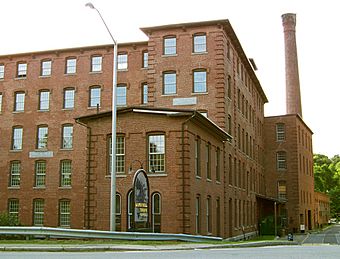Damon Mill facts for kids
Quick facts for kids |
|
|
Damon Mill
|
|

Street View of the Damon Mill
|
|
| Location | Pond Lane, Concord, Massachusetts |
|---|---|
| Area | 4.5 acres (1.8 ha) |
| Built | 1862 |
| Architect | Elbridge Boyden |
| Architectural style | Italianate |
| NRHP reference No. | 79000360 |
| Added to NRHP | May 25, 1979 |
The Damon Mill is a historic building in Concord, Massachusetts, located right by the Assabet River. This old mill has a long history, starting way back in the 1600s! It was once a busy place where things like iron and cloth were made. The building you see today was built in 1862 and is now listed on the National Register of Historic Places, which means it's an important part of history.
Contents
What is the Damon Mill?
The Damon Mill is a large building that used to be a factory. It's found at 9 Pond Lane in Concord, Massachusetts. For many years, it was a key spot for making different products. The mill sits next to the Assabet River, which provided the power it needed to run its machines.
Early Days of the Mill
The area around the Assabet River in Concord has been used for industry since about 1660. Back then, people set up a "bog iron works" to get iron from the ground. Soon after, a dam was built on the river. This dam helped power mills that ground grain into flour (gristmills) and cut wood (sawmills) for the local farmers.
The first mill to make cloth, called a textile mill, was built here in 1808. It was started by John Brown, whose father was a local cloth maker. This mill made cotton goods. Over time, the mill had different owners.
The Damon Family Takes Over
In 1834, a man named Calvin Carver Damon bought the mill. He made many improvements, like fixing the dam and adding a better water wheel. This made the mill work more efficiently.
Later, in 1854, Calvin's son, Edward Carver Damon, took over the business. The Damon Mill became famous for making a special fabric called "domett cloth." This was a light flannel fabric made from both wool and cotton. Calvin Damon invented it, and it became a popular material for clothing.
By the 1870s, the mill was making many different types of fabrics. It was a big employer in the area, with about 175 workers.
Fire, Rebuilding, and New Uses
On June 19, 1862, a big fire destroyed the wooden mill building. But Edward Damon didn't give up! He worked with an architect named Elbridge Boyden to rebuild the mill in the very same year. The new mill continued to make textiles until the 1890s.
After the Damon family sold the mill, other companies used it to make different types of cloth. However, because the mill was a bit small, it eventually closed its textile operations.
From about 1930 to 1973, the building had a very different job: it was used to keep apples cold! Today, the Damon Mill has been fixed up and is now used as office space for various businesses. It's a great example of how old buildings can be given new life.



